标签:控件 资源 apk mode bitmap 运行 tools UI win
原文来自:http://www.runoob.com/w3cnote/android-tutorial-imageview.html
本节介绍的UI基础控件是:ImageView(图像视图),见名知意,就是用来显示图像的一个View或者说控件! 官方API:ImageView;本节讲解的内容如下:
在API文档中我们发现ImageView有两个可以设置图片的属性,分别是:src和background
常识:
①background通常指的都是背景,而src指的是内容!!
②当使用src填入图片时,是按照图片大小直接填充,并不会进行拉伸
而使用background填入图片,则是会根据ImageView给定的宽度来进行拉伸
写个简单的布局测试下:
<LinearLayout xmlns:android="http://schemas.android.com/apk/res/android" xmlns:tools="http://schemas.android.com/tools" android:id="@+id/LinearLayout1" android:layout_width="match_parent" android:layout_height="match_parent" android:orientation="vertical" tools:context="com.jay.example.imageviewdemo.MainActivity" > <ImageView android:layout_width="wrap_content" android:layout_height="wrap_content" android:background="@drawable/pen" /> <ImageView android:layout_width="200dp" android:layout_height="wrap_content" android:background="@drawable/pen" /> <ImageView android:layout_width="wrap_content" android:layout_height="wrap_content" android:src="@drawable/pen" /> <ImageView android:layout_width="200dp" android:layout_height="wrap_content" android:src="@drawable/pen" /> </LinearLayout>
效果图如下:
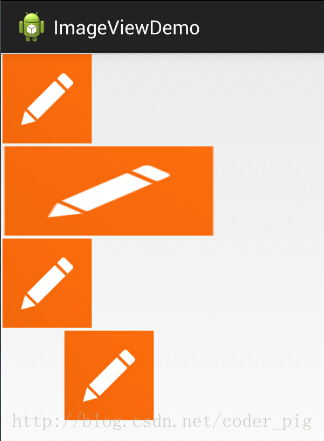
结果分析:
宽高都是wrap_content那就一样,是原图大小,但是,当我们固定了宽或者高的话, 差别就显而易见了,blackground完全填充了整个ImageView,而src依旧是那么大, 而且他居中了哦,这就涉及到了ImageView的另一个属性scaleType了! 另外还有一点,这里我们说了只设置width或者height哦!加入我们同时设置了 width和height的话,blackground依旧填充,但是,src的大小可能发生改变哦! 比如,我们测试下下面这段代码:
<ImageView android:layout_width="100dp" android:layout_height="50dp" android:src="@drawable/pen" />
运行效果图:
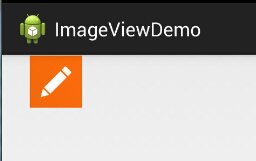
PS:scaleType下面会讲~
在前面的效果图中的第二个Imageview中我们可以看到图片已经被拉伸变形了, 正方形变成了长方形,对于和我一样有轻微强迫症的人来说,显然是不可接受的, 有没有办法去设置呢?答案肯定是有的,笔者暂时知道的有以下两种方式:
这个适用于动态加载ImageView的,代码也渐渐,只要在添加View的时候,把大小写死就可以了
LinearLayout.LayoutParams layoutParam = new LinearLayout.LayoutParams(48, 48); layout.addView(ibtnPen, layoutParam);
除了动态加载view,更多的时候,我们还是会通过xml布局的方式引入ImageView的 解决方法也不难,就是通过drawable的Bitmap资源文件来完成,然后blackground属性设置为该文件即可! 这个xml文件在drawable文件夹下创建,这个文件夹是要自己创建的哦!!
pen_bg.xml:
<bitmap xmlns:android="http://schemas.android.com/apk/res/android" android:id="@id/pen_bg" android:gravity="top" android:src="@drawable/pen" android:tileMode="disabled" > </bitmap>
上述代码并不难理解,估计大家最迷惑的是titleMode属性吧,这个属性是平铺,就是我们windows设置 背景时候的平铺,多个小图标铺满整个屏幕捏!记得了吧!不记得自己可以试试!disabled就是把他给禁止了!
就是上面这串简单的代码,至于调用方法如下:
动态: ibtnPen.setBacklgroundResource(R.drawable.penbg);
静态: android:background = "@drawable/penbg"
说完前面两个区别,接着再说下setAlpha属性咯!这个很简单,这个属性,只有src时才是有效果的!!
网上的一张图:
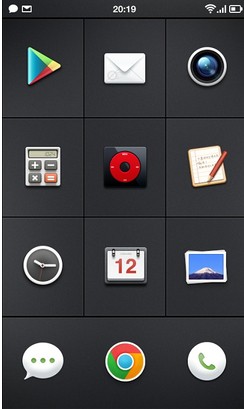
一看去是一个简单的GridView,每个item都是一个ImageView,但是细心的你可能发现了, 上面的ICON都不是规则的,而是圆形,圆角矩形等等,于是乎这里用到了src + background了! 要实现上述的效果,你只需要两个操作: 找一张透明的png图片 + 设置一个黑色的背景 (当然你也可以设置png的透明度来实现,不过结果可能和预想的有出入哦!) 我们写个简单例子:
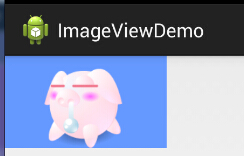
如图,呆萌呆萌的小猪就这样显示到ImageView上了,哈哈,blackground设置了蓝色背景!
实现代码:
<ImageView android:layout_width="150dp" android:layout_height="wrap_content" android:src="@drawable/pig" android:background="#6699FF" />
PS: 当然你也可以用selctor实现点击效果,设置不同的情况设置不同的图片,以实现点击或者触摸效果!
前景(对应src属性):setImageDrawable( );
背景(对应background属性):setBackgroundDrawable( );
ImageView为我们提供了adjustViewBounds属性,用于设置缩放时是否保持原图长宽比! 单独设置不起作用,需要配合maxWidth和maxHeight属性一起使用!而后面这两个属性 也是需要adjustViewBounds为true才会生效的~
- android:maxHeight:设置ImageView的最大高度
- android:maxWidth:设置ImageView的最大宽度
代码示例:
<LinearLayout xmlns:android="http://schemas.android.com/apk/res/android" xmlns:tools="http://schemas.android.com/tools" android:layout_width="match_parent" android:layout_height="match_parent" android:orientation="vertical" tools:context=".MainActivity"> <!-- 正常的图片 --> <ImageView android:id="@+id/imageView1" android:layout_width="wrap_content" android:layout_height="wrap_content" android:layout_margin="5px" android:src="@mipmap/meinv" /> <!-- 限制了最大宽度与高度,并且设置了调整边界来保持所显示图像的长宽比--> <ImageView android:id="@+id/imageView2" android:layout_width="wrap_content" android:layout_height="wrap_content" android:layout_margin="5px" android:adjustViewBounds="true" android:maxHeight="200px" android:maxWidth="200px" android:src="@mipmap/meinv" /> </LinearLayout>
运行效果图:
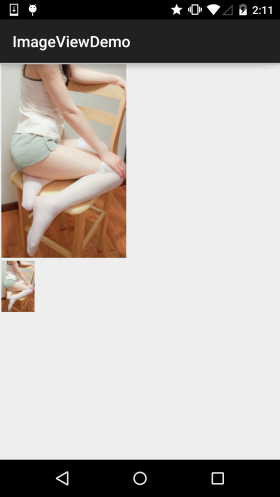
结果分析: 大的那个图片是没有任何处理的图片,尺寸是:541374;而下面的那个的话我们通过maxWidth和maxHeight 限制ImageView最大宽度与高度为200px,就是最多只能显示200200的图片,我们又设置了一个 adjustViewBounds = "true"调整我们的边界来保持图片的长宽比,此时的ImageView宽高为是128*200~
android:scaleType用于设置显示的图片如何缩放或者移动以适应ImageView的大小 Java代码中可以通过imageView.setScaleType(ImageView.ScaleType.CENTER);来设置~ 可选值如下:
- fitXY:对图像的横向与纵向进行独立缩放,使得该图片完全适应ImageView,但是图片的横纵比可能会发生改变
- fitStart:保持纵横比缩放图片,知道较长的边与Image的编程相等,缩放完成后将图片放在ImageView的左上角
- fitCenter:同上,缩放后放于中间;
- fitEnd:同上,缩放后放于右下角;
- center:保持原图的大小,显示在ImageView的中心。当原图的size大于ImageView的size,超过部分裁剪处理。
- centerCrop:保持横纵比缩放图片,知道完全覆盖ImageView,可能会出现图片的显示不完全
- centerInside:保持横纵比缩放图片,直到ImageView能够完全地显示图片
- matrix:默认值,不改变原图的大小,从ImageView的左上角开始绘制原图, 原图超过ImageView的部分作裁剪处理
接下来我们一组组的来对比:
这里以fitEnd为例,其他两个类似:
示例代码:
<!-- 保持图片的横纵比缩放,知道该图片能够显示在ImageView组件上,并将缩放好的图片显示在imageView的右下角 --> <ImageView android:id="@+id/imageView3" android:layout_width="300px" android:layout_height="300px" android:layout_margin="5px" android:scaleType="fitEnd" android:src="@mipmap/meinv" />
运行效果图:
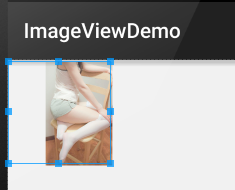
示例代码:
<ImageView android:layout_width="300px" android:layout_height="300px" android:layout_margin="5px" android:scaleType="centerCrop" android:src="@mipmap/meinv" /> <ImageView android:layout_width="300px" android:layout_height="300px" android:layout_margin="5px" android:scaleType="centerInside" android:src="@mipmap/meinv" />
运行效果图:
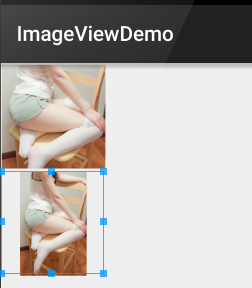
不按比例缩放图片,目标是把图片塞满整个View
示例代码:
<ImageView android:layout_width="300px" android:layout_height="300px" android:layout_margin="5px" android:scaleType="fixXY" android:src="@mipmap/meinv" />
运行效果图:
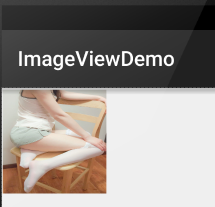
好吧,明显扁了=-=~
从ImageView的左上角开始绘制原图,原图超过ImageView的部分作裁剪处理
示例代码:
<ImageView android:layout_width="300px" android:layout_height="300px" android:layout_margin="5px" android:scaleType="matrix" android:src="@mipmap/meinv" />
运行效果图:
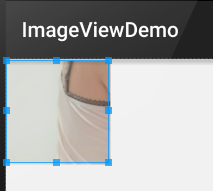
保持原图的大小,显示在ImageView的中心。当原图的size大于ImageView的size,超过部分裁剪处理。
示例代码:
<ImageView android:layout_width="300px" android:layout_height="300px" android:layout_margin="5px" android:scaleType="center" android:src="@mipmap/meinv" />
运行效果图:
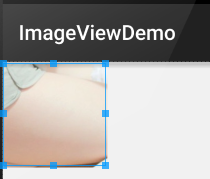
相信大家对圆形或者圆角的ImageView不陌生吧,现在很多的APP都很喜欢圆形的头像是吧~
这里就简单的写个圆形的ImageView吧,当然这只是一个示例,再不考虑性能与抗锯齿的情况下!!!
可以说是写来玩玩,实际项目的话可以考虑用Github上牛人写的控件,比如下面这两个:
git怎么玩前面已经教过大家了~把项目clone下来把相关文件复制到自己的项目即可~
标签:控件 资源 apk mode bitmap 运行 tools UI win
原文地址:http://www.cnblogs.com/zc2014blog/p/6886214.html